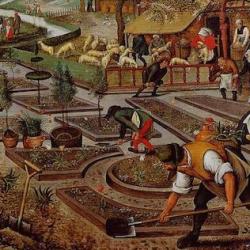An article by A. Edward Siecienski (in Wealth and Poverty in Early Church and Society (Holy Cross Studies in Patristic Theology and History) ) raises the question of the balance between liturgical splendor and poverty relief in the early church. He points out that even John Chrysostom, who thundered so vigorously against the exploitation of the rich, preached in a cathedral in Constantinople and paraded the city behind silver crosses he had received as a gift from the empress.
Virutally no one, even the most severe ascetic, said that the use of gold and silver and marble was inherently wrong. Jerome did not “blame” people who built churches with marble, large columns with gold capitals, silver doors and jewel-crusted altars: “Everyone must follow his own judgment.” But he went on to tell his friend Demetrius that his particular calling was to “clothe Christ in the poor, to visit Him in the wick, to feed Him in the hungry, and to shelter Him in the homeless.”
Chrysostom expressed this “priority of charity over liturgical splendor” in similar Christological terms in a sermon on Matthew:
“what is the profit, when HIs table indeed is full of golden cups, but He perishes with hunger? First fill Him, being hungered, and then abundantly deck out His table also. Do you make Him a cup of gold, while you refuse Him a cup of cold water? And what is the profit? Do you furnish His table with cloths bespangled with gold, while you refuse Him even the necessary covering? And what good comes of it? Do not therefore while adorning His house overlook your brother in distress, for he is more properly a temple than the other . . . . I say this, not forbidding such offerings [for adornment]; but requiring you, together with them, and before them, to give alms.”














